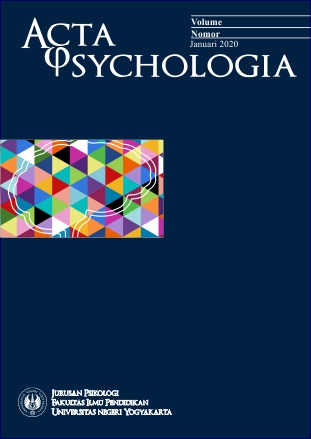Problematic Internet Use Questionnaire-Revised (PIUQ-R) versi Indonesia: Pengembangan dan analisis properti psikometri
DOI:
https://doi.org/10.21831/ap.v7i1.87680Keywords:
psikometri; problematic internet use; PIUQ; validitas; reliabilitasAbstract
Prevalensi penggunaan internet yang bermasalah atau disebut sebagai problematic internet use (PIU) mengalami peningkatkan dari tahun ke tahun sehingga diperlukan sebuah alat ukur guna mendeteksi perilaku tersebut. Di Indonesia, sudah dikembangkan Problematic Internet Use Questionnaire (PIUQ) berbahasa Indonesia, namun beberapa item dinilai masih membingungkan dan sampel terbatas. Penelitian ini bertujuan untuk merevisi item dan menguji ulang analisis properti psikometri dengan melibatkan subjek dengan karakteristik yang lebih luas. Partisipan dalam penelitian ini sebanyak 301 orang yang berdomisili di Jawa Timur, Jawa Tengah, dan Daerah Istimewa Yogyakarta. Instrumen dalam penelitian ini menggunakan Problematic Internet Use Questionnaire (PIUQ) versi Indonesia dan Beck Depression Inventory-II (BDI-II). Teknik analisis data dalam penelitian ini yaitu pengumpulan bukti validitas dan estimasi reliabilitas. Hasil analisis menunjukkan bahwa PIUQ versi revisi memiliki struktur faktor yang sesuai dan menunjukkan reliabilitas yang baik. Dengan demikian, PIUQ versi revisi dapat digunakan sebagai alat skrining yang valid dan reliabel untuk mendeteksi kecenderungan penggunaan internet yang bermasalah di Indonesia, khususnya dalam konteks penelitian, namun, belum direkomendasikan untuk tujuan diagnosis klinis.
References
Abiddine, F. Z. El, Aljaberi, M. A., Gadelrab, H. F., Lin, C.-Y., & Muhammed, A. (2022). Mediated effects of insomnia in the association between problematic social media use and subjective well-being among university students during COVID-19 pandemic. Sleep Epidemiology, 2(June), 100030. https://doi.org/10.1016/j.sleepe.2022.100030
Agriyani, M. A., & Widyastuti, T. (2023). Adaptasi skala problematic internet se Questionnaire ( PIUQ ) versi Indonesia ( Adaptation of the Problematic Internet Use Questionnaire ( PIUQ ) Scale Indonesian Version ). 22(2), 157–167. https://doi.org/10.24167/psidim.
Aivali, P., Efthymiou, V., Tsitsika, A. K., Vlachakis, D., Chrousos, G. P., Kanaka-Gantenbein, C., & Bacopoulou, F. (2021). Validation of the Greek version of the Problematic Internet Use Questionnaire - Short Form (PIUQ-SF-6). EMBnet.Journal, 26(1), e978. https://doi.org/10.14806/ej.26.1.978
Amichai-Hamburger, Y., & Ben-Artzi, E. (2003). Loneliness and internet use. Computers in Human Behavior, 19(1), 71–80. https://doi.org/10.1016/S0747-5632(02)00014-6
Andangsari, E. W., Djunaidi, A., Fitriana, E., & Harding, D. (2019). Indonesia problematic internet se scale. Journal of Physics: Conference Series, 1175(1). https://doi.org/10.1088/1742-6596/1175/1/012239
APJII. (2023). Survei Internet Indonesia 2023 Tahap 1. Asosiasi penyelenggara jasa internet Indonesia, 2023. www.survei.apjii.or.id
APJII. (2024). APJII Jumlah Pengguna Internet Indonesia Tembus 221 Juta Orang. Asosiasi penyelenggara jasa internet Indonesia, 2024. www.survei.apjii.or.id
Asanda, N. C. (2017). Hubungan antara problematic internet use dengan loneliness. FPsi UI, 2017.
Babbie, E. (2014). The Basics of Social Research (6th ed.). Wadsworth, Cengage Learning.
Beaton, D. E., Bombardier, C., Guillemin, F., & Ferraz, M. B. (2000). Guidelines for the Process of cross-cultural adaptation of self-report measures. In Spine (Vol. 25, Issue 24).
Burkauskas, J., Király, O., Demetrovics, Z., Podlipskyte, A., & Steibliene, V. (2020). Psychometric properties of the nine-item problematic internet use questionnaire (PIUQ-9) in a lithuanian sample of students. Frontiers in Psychiatry, 11(November), 1–6. https://doi.org/10.3389/fpsyt.2020.565769
Cai, Z., Mao, P., Wang, Z., Wang, D., He, J., & Fan, X. (2023). Associations between problematic internet use and mental health outcomes of students: A Meta-analytic Review. Adolescent Research Review, 8(1), 45–62. https://doi.org/10.1007/s40894-022-00201-9
Caplan, S. E. (2002a). Problematic internet use and psychosocial well-being: development of a theory-based cognitive-behavioral measurement instrument. Computers in Human Behavior, 18(5), 553–575. https://doi.org/10.1016/S0747-5632(02)00004-3
Caplan, S. E. (2002b). Problematic internet use and psychosocial well-being: development of a theory-based cognitive-behavioral measurement instrument 2 ( 0 2 ) 0 0 0 0 4-3. In Computers in Human Behavior (Vol. 18). www.elsevier.com/locate/comphumbeh
Chao, C. M., Kao, K. Y., & Yu, T. K. (2020). Reactions to problematic internet use among adolescents: Inappropriate physical and mental health perspectives. Frontiers in Psychology, 11(July), 1–12. https://doi.org/10.3389/fpsyg.2020.01782
Chen, I. H., Ahorsu, D. K., Pakpour, A. H., Griffiths, M. D., Lin, C. Y., & Chen, C. Y. (2020). Psychometric properties of three simplified chinese online-related ddictive behavior nstruments among mainland chinese primary school students. Frontiers in Psychiatry, 11(September), 1–8. https://doi.org/10.3389/fpsyt.2020.00875
Chen, Y. L., & Gau, S. S. F. (2016). Sleep problems and internet addiction among children and adolescents: a longitudinal study. Journal of Sleep Research, 25(4), 458–465. https://doi.org/10.1111/jsr.12388
Demetrovics, Z., Király, O., Koronczai, B., Griffiths, M. D., Nagygyörgy, K., Elekes, Z., Tamás, D., Kun, B., Kökönyei, G., & Urbán, R. (2016). Psychometric properties of the Problematic Internet Use Questionnaire Short-Form (PIUQ-SF-6) in a Nationally representative sample of adolescents. PLoS ONE, 11(8). https://doi.org/10.1371/journal.pone.0159409
Demetrovics, Z., Szeredi, B., & Rózsa, S. (2008). The three-factor model of Internet addiction: The development of the Problematic Internet Use Questionnaire. Behavior Research Methods, 40(2), 563–574. https://doi.org/10.3758/BRM.40.2.563
Esen, B. K., Aktas, E., & Tuncer, I. (2013). An analysis of university students’ internet use in relation to loneliness and social self-efficacy. Procedia - Social and Behavioral Sciences, 84, 1504–1508. https://doi.org/10.1016/j.sbspro.2013.06.780
Feher, A., Fejes, E., Kapus, K., Jancsak, C., Nagy, G. D., Horvath, L., Tibold, A., & Feher, G. (2023). The association of problematic usage of the internet with burnout, depression, insomnia, and quality of life among Hungarian high school students. Frontiers in Public Health, 11(July). https://doi.org/10.3389/fpubh.2023.1167308
Furr, R. M. (2022). Psychometrics Fourth Edition (Fourth). SAGE Publications.
Ginting, H., Näring, G., Van Der Veld, W. M., Srisayekti, W., & Becker, E. S. (2013). Validating the beck depression inventory-II in indonesia’s general population and coronary heart disease patients. International Journal of Clinical and Health Psychology, 13(3), 235–242. https://doi.org/10.1016/S1697-2600(13)70028-0
Göktaş, S., Aygar, H., Akbulut Zencirci, S., Önsüz, M. F., Alaiye, M., & Metintaş, S. (2018). Problematic internet use questionairre-short form-6 (PIUQ-SF 6): a validity and reliability study in Turkey. International Journal of Research in Medical Sciences, 6(7), 2354. https://doi.org/10.18203/2320-6012.ijrms20182816
Gregory, R. J. (2013). Psychological testing. In The Encyclopedia of Parenting Theory and Research. https://doi.org/10.5005/jp/books/11437_16
Hair, J.F., Black, W. C., Babin, B. J., Anderson, R. E. (2018). Multivariate Data Analysis. https://doi.org/10.1002/9781119409137.ch4
Horwood, S., & Anglim, J. (2019). Problematic smartphone usage and subjective and psychological well-being. Computers in Human Behavior, 97(March), 44–50. https://doi.org/10.1016/j.chb.2019.02.028
Hu, L. T., & Bentler, P. M. (1999). Cutoff criteria for fit indexes in covariance structure analysis: Conventional criteria versus new alternatives. Structural Equation Modeling, 6(1), 1–55. https://doi.org/10.1080/10705519909540118
Kern, L., & Acier, D. (2013). French adaptation of the problematic nternet use questionnaire. Evolution Psychiatrique, 78(3), 357–371. https://doi.org/10.1016/j.evopsy.2012.07.002
Khazaal, Y., Chatton, A., Horn, A., Achab, S., Thorens, G., Zullino, D., & Billieux, J. (2012). French validation of the compulsive internet use scale (CIUS). Psychiatric Quarterly, 83(4), 397–405. https://doi.org/10.1007/s11126-012-9210-x
Kline, R.B. (2016). Principles and practice of structural equation modelling (4th ed.). The Guilford Press
Laconi, S., Urbán, R., Kaliszewska-Czeremska, K., Kuss, D. J., Gnisci, A., Sergi, I., Barke, A., Jeromin, F., Groth, J., Gamez-Guadix, M., Ozcan, N. K., Siomos, K., Floros, G. D., Griffiths, M. D., Demetrovics, Z., & Király, O. (2019). Psychometric evaluation of the nine-item problematic Internet use questionnaire (PIUQ-9) in nine European samples of internet users. Frontiers in Psychiatry, 10(MAR). https://doi.org/10.3389/fpsyt.2019.00136
Mahamid, F. A., Berte, D. Z., & Bdier, D. (2022). Problematic internet use and its association with sleep disturbance and life satisfaction among Palestinians during the COVID-19 pandemic. Current Psychology, 41(11), 8167–8174. https://doi.org/10.1007/s12144-021-02124-5
Miller, L. A., & Lovler, R. L. (2020). Foundations of Psychological Testing (Sixth). SAGE Publications.
Mozafar Saadati, H., Mirzaei, H., Okhovat, B., & Khodamoradi, F. (2021). Association between internet addiction and loneliness across the world: A meta-analysis and systematic review. In SSM - Population Health (Vol. 16). Elsevier Ltd. https://doi.org/10.1016/j.ssmph.2021.100948
Nurafifah, N., & Ilmi Hatta, M. (2023). Pengaruh problematic internet use terhadap subjective well-being pada mahasiswa universitas islam bandung. Bandung Conference Series: Psychology Science, 3(2), 1050–1057. https://doi.org/10.29313/bcsps.v3i2.9493
Opakunle, T., Aloba, O., Opakunle, O., & Eegunranti, B. (2020). Problematic internet use questionnaire-short form-6 (PIUQ-SF-6): dimensionality, validity, reliability, measurement invariance and mean differences across genders and age categories among Nigerian adolescents. International Journal of Mental Health, 49(3), 229–246. https://doi.org/10.1080/00207411.2020.1776457
Sayeed, A., Rahman, M. H., Hassan, M. N., Christopher, E., Kundu, S., Banna, M. H. Al, Hasan, A. R., Mallick, T., Meem, A. E., & Hasan, M. T. (2021). Problematic internet use associated with depression, health, and internet-use behaviors among university students of Bangladesh: A cross-sectional study. Children and Youth Services Review, 120, 105771. https://doi.org/10.1016/j.childyouth.2020.105771
Setiawati, F. A., Widyastuti, T., & Bagaskara, R. S. (2024). Pengukuran Properti Psikometri. UNY Press.
Shapira, N. A., Lessig, M. C., Goldsmith, T. D., Szabo, S. T., Lazoritz, M., Gold, M. S., & Stein, D. J. (2003). Problematic internet use: Proposed classification and diagnostic criteria. Depression and Anxiety, 17(4), 207–216. https://doi.org/10.1002/da.10094
Spritzer, D. T., Machado, W. de L., Yates, M. B., Astolfi, V. R., Laskoski, P., Pessi, C., Laconi, S., Kaliszewska-Czeremska, K., Demetrovics, Z., Király, O., Passos, I. C., & Hauck, S. (2021). Psychometric properties of the nine-item problematic internet use questionnaire in a brazilian general population sample. Frontiers in Psychiatry, 12(May), 1–8. https://doi.org/10.3389/fpsyt.2021.660186
Urbina, S. (2004). Essentials of Psychological Testing. John Willey & Sons, Inc
Downloads
Published
How to Cite
Issue
Section
License
Copyright (c) 2025 Mardika Ayu Agriyani

This work is licensed under a Creative Commons Attribution-ShareAlike 4.0 International License.
Acta Psychologia allows readers to read, download, copy, distribute, print, search, or link to its articles' full texts and allows readers to use them for any other lawful purpose. The journal allows the author(s) to hold the copyright without restrictions. Finally, the journal allows the author(s) to retain publishing rights without restrictions
- Authors are allowed to archive their submitted article in an open access repository
- Authors are allowed to archive the final published article in an open access repository with an acknowledgment of its initial publication in this journal

This work is licensed under a Creative Commons Attribution-ShareAlike 4.0 Generic License.










